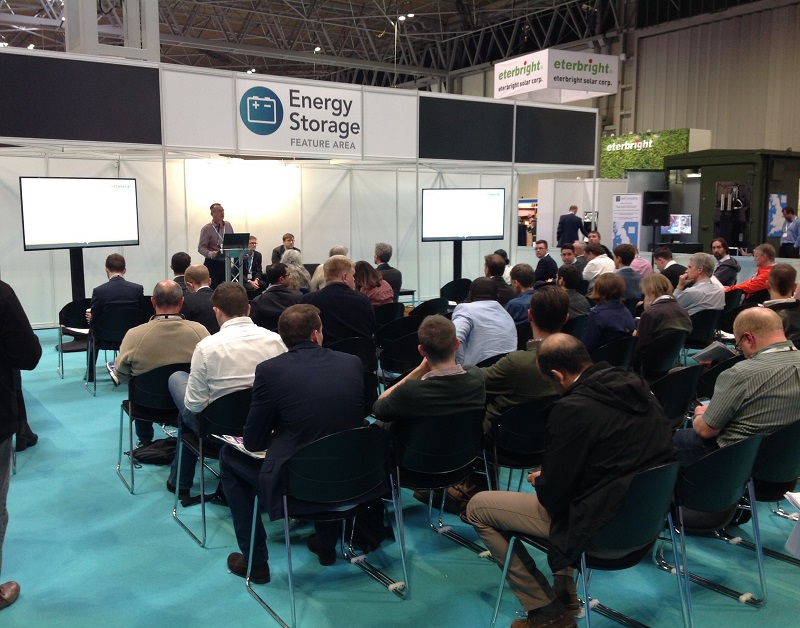Solar and Storage, a U.K.-based photovoltaic industry show, kicked off this week in Birmingham and concludes today. This is an annual show concerning the U.K.’s solar PV sector but, given that the country’s PV development has been a rollercoaster over the past few years, the show has sought to mirror these ups and downs with constant name changes and shifts in its focus as it looks to reinvent itself. Last year it was called Clean Energy Live, while for a few years before that it was known as the Solar Energy UK show.
This year’s Solar and Storage moniker is not a surprise. The pace of new PV installations in the U.K. in the post-subsidy era has decreased, and following the release of a smart systems and flexibility plan by the government and the national energy regulator in July, a lot of U.K.-based solar PV developers hope they can ride the forthcoming energy storage wave, most possibly combining batteries with existing PV plants.
Beyond the U.K., another point of focus is the neighboring Republic of Ireland. Ireland has currently in place the so-called Renewable Electricity Support Scheme (RESS) consultation. This concludes in November and is expected to be followed by some sort of new support scheme for renewable energy projects, including solar energy, via, for example, an auction scheme.
Meanwhile, until the RESS consultation ends and a new policy is designed and implemented, Ireland’s PV development is taking place on Irish rooftops – despite the government offering no feed-in tariff or any other kind of support. Of the 10 MW of PV capacity installed today in the country, the vast majority is rooftop projects.
When rooftop PV works
Robert Gross, director of Solar Electric Ireland, explained to the Solar and Storage show why and how such projects can be a success. The main drivers are electricity costs and the profile of the rooftop owner, said Gross. Business owners who aim to save on electricity costs and have a green agenda are the first adopters of PV technology in Ireland.
Gross claimed that under specific conditions rooftop PV projects in Ireland today can achieve an internal rate of return (IRR) up to 13% and a payback period up to 10 years. This is possible when a business is open seven days a week and does not close for certain time periods (e.g. during summer holidays). Unfortunately, some typical PV cases in other countries, like school rooftops, do not offer a workable business model in Ireland at the moment.
Falling technology and installation costs help, too. Solar Electric Ireland, revealed Gross, installed a 250 kW PV system on the roof of an Irish business in 2015 with a build cost about €285,000, while in September this year it installed a 90 kW rooftop PV system for Ireland’s army with a build cost of just €80,000. The net cost in the most recent case was €810 per kW.
Another piece of positive news for Ireland’s rooftop PV sector is a new regulation regarding new commercial buildings. According to this regulation, from 2020 onwards all new commercial buildings will need to provide a percentage of their energy consumption via renewable energy systems such as PV or heat pump systems.
Of course, there are challenges that also concern the development of the Irish rooftop PV market. Among these, said Gross, are the high interest rates offered by commercial Irish banks. Therefore, there is an opportunity for European banks to enter the market and offer competitive interest rates.
Other barriers, Gross added, include the fact that planners and the public are not overly familiar with the technology yet, and can sometimes display a hostile attitude towards PV.
The RESS consultation
The outcome of the government’s RESS consultation might offer additional opportunities for Ireland’s PV, especially large ground-mounted PV farms. Based on the applications for grid connection, Ireland has a pipeline of aroun 6 GW of PV capacity, with the majority of projects been concentrated in the south and the east of the country. In the main, these mooted projects are under 5 MW each and comprise about 1.8 GW of the pipeline. Larger projects, those above 20 MW, number just 70 but account for 3 GW of the pipeline. By the time the RESS consultation translates to a policy framework, many of these projects might have received an agreement to connect to the grid.
Gross did not appear very optimistic regarding the RESS’s effect on the rooftop sector. He argued that if the new policy places solar PV in the same auction pot together with other renewable energy technologies, only very big plants will materialize due to economies of scale. On the rooftop category too, Gross said, the research behind the RESS consultation makes faulty assumptions regarding PV costs.
Until the RESS consultation and a new policy scheme bear some fruits, Ireland’s PV activity will remain firmly focused on the country’s commercial rooftops.
This content is protected by copyright and may not be reused. If you want to cooperate with us and would like to reuse some of our content, please contact: editors@pv-magazine.com.



Very informative on Solar PV projects being effected worldwide